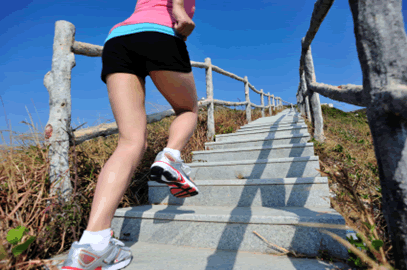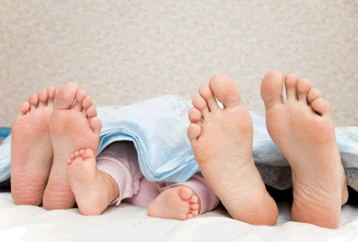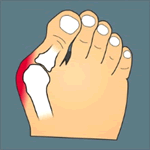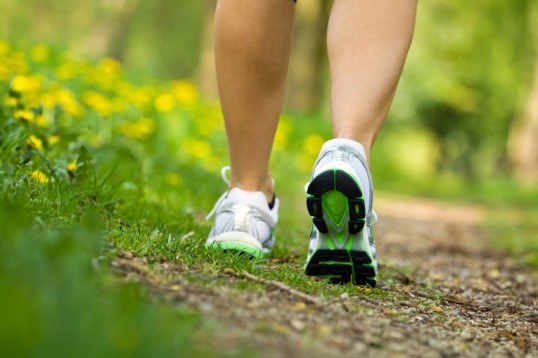Items filtered by date: May 2015
Four Steps to Preventing Running Injuries
 Kathleen Trotter, personal trainer and writer for the Huffington Post, has developed four steps to ensure injury free running.
Kathleen Trotter, personal trainer and writer for the Huffington Post, has developed four steps to ensure injury free running.
Step1: Make recovery top priority. Be sure schedule stretches, massages, and get enough rest for the body to recover after running.
Step 2: Listen to your body. If you are experiencing foot pain during your running session, don’t ignore the pain. Instead participate in another exercise that puts less pressure on the feet.
Step 3: Progress gradually. If you have spent all winter doing everything but running, it is not a good idea to start running at an extreme level. Instead work your way back into running for long periods of time.
Step 4: Do not just solely run. Since running is so hard on the body and puts a lot of stress on the joints, tendons, and ligaments, it is a good idea to mix up exercises by trying strength training, core training, stretching, and massaging to reduce these stresses.
Runners can still be prone to running injuries even with proper precautions. If you are suffering from a running injury see Dr. Joshua David Scoll of Pennsylvania. Our doctor will provide you with quality treatment and assist you with all of your foot and ankle concerns.
How to Prevent Running Injuries
Many common running injuries are caused by overuse and overtraining. When the back of the kneecap starts wearing out and starts causing pain in your knee, this is commonly referred to as runner’s knee. Runner’s knee is a decrease in strength in your quadriceps and can occur if you’re not wearing properly fitted or supporting shoes. To prevent runner’s knee, focusing on hip strengthening is a good idea, as well as strengthening your quads to keep the kneecaps aligned.
What Are Some Causes of Running Injuries?
- One cause of a common running injury is called iliotibial band syndrome.
- Plantar fasciitis is also another common injury.
- Stress fractures can occur from overtraining, lack of calcium, or even your running style.
Best Ways to Prevent Running Injuries
- Wear footwear that fits properly and suits your running needs.
- Running shoes are the only protective gear that runners have to safeguard them from injury.
- Make a training schedule. Adding strengthening exercises as well as regular stretching can help keep you strong and limber and can lessen the possibility of injuries.
- Stretching keeps muscles limber, this will help you gain better flexibility.
If you have any questions, please contact our offices located in Philadelphia and Bensalem, PA. We offer the newest diagnostic and treatment technologies for all your foot care needs.
Treatment for Flat Feet not always Necessary
 Flat feet occur through the over pronation of the foot, through a deformity at birth where the arch is typically flexible, or acquired over time when pressure is applied to the foot and the arch collapses. Improper footwear, foot abnormalities, or a ruptured tendon can all also lead to a flat foot. Typically if no pain is present, treatment may not be required other than wearing orthotics. However, if there is pain in a flat foot treatment can range from taping the foot, wearing custom orthotics, stretching, or fixing the ailment with surgery in extreme cases.
Flat feet occur through the over pronation of the foot, through a deformity at birth where the arch is typically flexible, or acquired over time when pressure is applied to the foot and the arch collapses. Improper footwear, foot abnormalities, or a ruptured tendon can all also lead to a flat foot. Typically if no pain is present, treatment may not be required other than wearing orthotics. However, if there is pain in a flat foot treatment can range from taping the foot, wearing custom orthotics, stretching, or fixing the ailment with surgery in extreme cases.
Living with flat feet does not always mean there will be a problem with them. If you are having trouble with your flat feet, speak to Dr. Joshua David Scoll of Pennsylvania. Our doctor will answer any of your foot and ankle related questions and attend to all of your podiatric needs.
What are Flat Feet?
Flat feet are a condition in which the arch of the foot is depressed and the sole of the foot is almost completely in contact with the ground. Standing about 20-30% of the population generally has flat feet because their arch never formed during growth.
Conditions & Problems:
Having flat feet makes it difficult to run or walk because of the stress placed on the ankles.
Alignment – The general alignment of your legs can be disrupted, because the ankles move inward which can cause major discomfort.
Knees – if you have complications with your knees, flat feet can be a contributor to arthritis in that area.
Symptoms:
- Pain around the heel or arch area
- Trouble standing on the tip toe.
- Swelling around the inside of the ankle.
- Flat look to one or both feet.
- Having your shoes feel uneven when worn
Treatment:
If you are experiencing pain and stress on the foot you may weaken the posterior tibial tendon, which runs around the inside of the ankle.
If you have any questions, please contact our offices located in Philadelphia and Bensalem, PA. We offer the newest diagnostic and treatment technologies for all your foot care needs.
Surgery Often Necessary in Treating Bunions
 Hallux valgus, or more commonly known as bunions, occurs when the joint of the big toe turns into a large bump and the big toe starts to turn into the smaller toes. Accordingly, the foot condition occurs in nearly one in three adults and can occur due to family genetics and through improper footwear. Bunion treatment typically begins with non-surgical treatments such as wearing a shoe with a wider toe box or wearing pads over the bump to cushion the area. When nonsurgical treatments do not work, surgery is considered as a last resort. With the surgery come risks such as scarring, bunion recurrence, arthritis, and other ailments. Recovery usually takes up to 12 weeks and a protective sandal or boot is necessary for proper healing.
Hallux valgus, or more commonly known as bunions, occurs when the joint of the big toe turns into a large bump and the big toe starts to turn into the smaller toes. Accordingly, the foot condition occurs in nearly one in three adults and can occur due to family genetics and through improper footwear. Bunion treatment typically begins with non-surgical treatments such as wearing a shoe with a wider toe box or wearing pads over the bump to cushion the area. When nonsurgical treatments do not work, surgery is considered as a last resort. With the surgery come risks such as scarring, bunion recurrence, arthritis, and other ailments. Recovery usually takes up to 12 weeks and a protective sandal or boot is necessary for proper healing.
The pain and discomfort caused by bunions can put a halt to everyday activities. If you have any concerns contact podiatrist Dr. Joshua David Scoll of Pennsylvania. Our doctor will treat your foot and ankle needs.
What is a Bunion?
A bunion is formed of swollen tissue or an enlargement of boney growth, usually located at the base joint of the toe that connects to the foot. The swelling occurs by the bones in the big toe shifting inward, which impacts the other toes of the foot. This causes the area around the base of the big toe to become inflamed and painful.
Why do Bunions Form?
• Genetics – susceptibility to bunions are often hereditary
• Stress on the feet – poorly fitted and uncomfortable footwear that places stress on feet, such as heels, can cause bunions to form
How are Bunions Diagnosed?
Doctors often perform two tests – blood tests and x-rays – when trying to diagnose bunions, especially in the early stages of development. Blood tests help determine if the foot pain is being caused by something else, such as arthritis, while x-rays provide a clear picture of your bone structure to your doctor.
How are Bunions Treated?
• Refrain from wearing heels or similar shoes that cause discomfort
• Select wider shoes that can provide more comfort and reduce pain
• Anti-inflammatory and pain management drugs
• Orthotics or foot inserts
• Surgery
If you have any concerns please feel free to contact our offices located in Philadelphia and Bensalem, PA. We offer the newest diagnostic tools and technology to treat your foot and ankle needs.
Proper Foot Support the Key to Athleticism
 According to Huffington Post Healthy Living, the best forms of agility, speed, balance, and power start with a properly supported foot. Although athletic footwear is designed to support and protect the foot with standard shock absorption, it does not protect the natural biomechanic movement of the foot or abnormal pronation of the foot and joints.
According to Huffington Post Healthy Living, the best forms of agility, speed, balance, and power start with a properly supported foot. Although athletic footwear is designed to support and protect the foot with standard shock absorption, it does not protect the natural biomechanic movement of the foot or abnormal pronation of the foot and joints.
To fill that void, athletes can purchase arch supports that are inserted in the shoes specific to the sport they participate in. Having a stable lower half will increase overall performance and help athlete’s prevent injury.
Proper foot support is of utmost importance in foot health. To learn more, consult with podiatrist Dr. Joshua David Scoll of Pennsylvania. Our doctor will provide you with the foot and ankle information you seek.
The Importance of Proper Foot Support
Walking is an everyday function for both men and women, and in order to keep your body’s balance in order, you are going to need shoes that provide the proper kinds of support.
Poor foot support can cause pain and discomfort in the lower back, hips, knees, neck and shoulder. It also can lead to emotional stress, and physiological changes in the body. In order to avoid these problems, you must have proper foot support.
The arch is the most important part of the foot, which is where most of the support and balance of your feet lies. The arch of your foot varies in height, and as you age, this height can change. Proper foot support will help musculoskeletal issues, which causes inactivity or disability.
When looking for shoes that give proper support to your feet, you should refrain from wearing ill-fitting shoes. If footwear is too tight, this can affect the body’s posture, stress, bone deformities, and other foot and back pain. Therefore, it is important that shoes fit well in order to avoid these complications.
If you have any questions please feel free to contact our office located in Philadelphia and Bensalem, PA. We offer the newest diagnostic tools and technology to treat your foot and ankle needs.
Read more about Proper Foot Support
